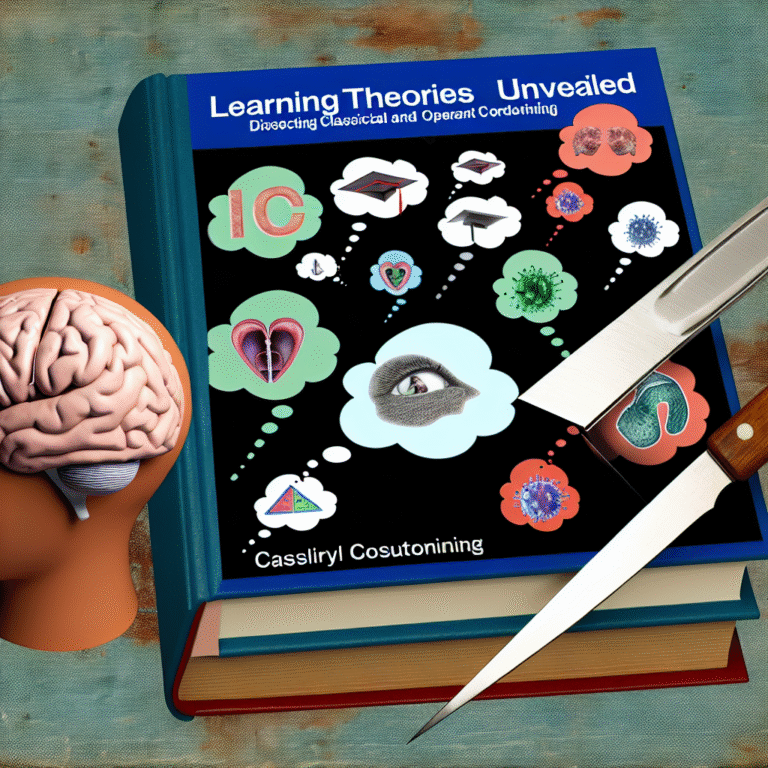
Behavior Modification Techniques: Classical Conditioning vs. Operant Conditioning Explained
Introduction
Imagine if the way you learned new behaviors and unlearned undesirable ones could be understood through two fundamental techniques—classical conditioning and operant conditioning. These behavior modification techniques have shaped how psychologists, educators, and therapists approach behavioral change in individuals. By mastering these approaches, not only can we better understand ourselves, but we can also enhance our interactions with others, from our pets to our children.
In this article, we will delve deep into the landscape of behavior modification techniques: classical conditioning vs. operant conditioning explained. We’ll explore the science behind each, real-world applications, and provide practical takeaways to empower you in applying these techniques effectively. Whether you are a parent, teacher, or simply interested in the mechanics of behavior modification, this guide will illuminate the path forward.
Understanding Behavior Modification Techniques
Before diving into the two primary techniques—in this case, classical conditioning and operant conditioning—it’s essential to establish a baseline understanding. Behavior modification involves altering behavior patterns by reinforcing desired behaviors or eliminating unwanted ones. Techniques can vary based on the underlying theory, objectives, and application.
Classical Conditioning: The Basics
Classical conditioning, first described by Ivan Pavlov, is a learning process that occurs through associations between an environmental stimulus and a naturally occurring stimulus. For instance, Pavlov’s experiments with dogs demonstrated how a neutral stimulus, like a bell, could become associated with food, causing dogs to salivate simply upon hearing the bell.
Key Components of Classical Conditioning
- Unconditioned Stimulus (US): This is a stimulus that naturally and automatically triggers a response without prior conditioning (e.g., food).
- Unconditioned Response (UR): This is an unlearned response that occurs naturally in reaction to the unconditioned stimulus (e.g., salivation).
- Conditioned Stimulus (CS): This is a previously neutral stimulus that, after conditioning, comes to trigger a conditioned response (e.g., the bell).
- Conditioned Response (CR): This is the learned response to the conditioned stimulus (e.g., salivation in response to the bell).
Case Study: Pavlov’s Dogs
Pavlov’s experiments involved ringing a bell every time he introduced food to the dogs. Eventually, the sound of the bell alone caused the dogs to salivate. The significance of this case study lies in its ability to demonstrate how behavior can be modified through simple associative learning, a fundamental concept in behavior modification techniques: classical conditioning vs. operant conditioning explained.
| Component | Example |
|---|---|
| Unconditioned Stimulus | Food |
| Unconditioned Response | Salivation |
| Conditioned Stimulus | Bell |
| Conditioned Response | Salivation in response to bell |
Operant Conditioning: A Different Approach
Operant conditioning, conceptualized by B.F. Skinner, revolves around the idea that behaviors are influenced by their consequences. This technique employs reinforcement or punishment to shape behavior—desired behaviors are reinforced, and undesirable behaviors are discouraged.
Key Components of Operant Conditioning
- Reinforcement: A stimulus that increases the likelihood of a behavior recurring. Reinforcement can be positive (adding a pleasant stimulus) or negative (removing an unpleasant stimulus).
- Punishment: A stimulus that decreases the likelihood of a behavior recurring. Like reinforcement, punishment can also be positive (adding an unpleasant stimulus) or negative (removing a pleasant stimulus).
- Schedules of Reinforcement: These are specific patterns that determine when a behavior will be reinforced, including fixed-ratio, variable-ratio, fixed-interval, and variable-interval schedules.
Case Study: Skinner’s Box
Skinner’s box was an experiment where animals like rats learned to associate pressing a lever with receiving food (positive reinforcement) or avoiding a shock (negative reinforcement). This study illustrates the core principles of operant conditioning, including how behavior can be modified through consequences, further contributing to the understanding of behavior modification techniques: classical conditioning vs. operant conditioning explained.
| Component | Example |
|---|---|
| Positive Reinforcement | Triggering a food reward for pressing a lever |
| Negative Reinforcement | Stopping an electric shock upon pressing a lever |
| Positive Punishment | Adding a loud noise when the wrong lever is pressed |
| Negative Punishment | Removing food after an undesired action |
Comparing Classical Conditioning and Operant Conditioning
While both classical conditioning and operant conditioning represent central theories in behavior modification techniques, they differ fundamentally in focus and process.
Nature of Learning
- Classical Conditioning: Learning through associations between stimuli.
- Operant Conditioning: Learning through consequences of behavior.
Application in Real Life
- Classical Conditioning: Often used in therapies for phobias, PTSD, and other anxiety-related disorders. For example, someone who has a fear of dogs may undergo exposure therapy that gradually associates the presence of dogs with positive experiences.
- Operant Conditioning: Commonly employed in educational settings and training animals. For instance, teachers may use praise or rewards to encourage participation in class, demonstrating how behavior modification techniques: classical conditioning vs. operant conditioning explained can manifest in classroom settings.
Effectiveness and Limitations
- Classical Conditioning: Effective for specific responses and range of emotions but may not address behavioral motivations.
- Operant Conditioning: Highly effective in shaping desired behaviors, but may require consistent reinforcement to be successful and can lead to dependency on rewards.
Techniques Derived from Classical and Operant Conditioning
Applications of Classical Conditioning
- Therapeutic Exposure: Used to treat phobias and anxiety disorders through gradually conditioned positive responses.
- Aversion Therapy: Involves associating unwanted behaviors (e.g., smoking) with unpleasant stimuli (e.g., nausea).
Applications of Operant Conditioning
- Behavioral Contracts: Establishing agreements that reinforce positive behavior changes (e.g., a child gets a reward for completing homework).
- Token Economies: Commonly used in schools and clinics, where individuals earn tokens for good behavior that can be exchanged for a reward.
Practical Takeaways For Using Behavior Modification Techniques
- Identify Goals: Clearly define the behavioral changes you want to achieve.
- Choose Your Technique: Decide whether classical conditioning or operant conditioning is the best fit for the behavior you want to modify.
- Implement Consistently: Consistent application is key—reinforcements or associations need to happen regularly to be effective.
- Assess and Adapt: Monitor progress and adjust your approach based on what works best.
Conclusion
Understanding behavior modification techniques: classical conditioning vs. operant conditioning explained offers invaluable insights into altering behaviors effectively. Each technique has its unique strengths and can be applied in various settings, from education to therapy.
When applied with intention and care, these techniques can help foster positive behavior and change. Whether you are a parent attempting to guide your child’s actions, a teacher motivating students, or simply someone interested in bettering themselves, mastering these principles can empower you to take control of behaviors—for yourself and those around you.
FAQs
1. What are Behavior Modification Techniques?
Behavior modification techniques involve strategies used to alter behaviors by reinforcing desired actions or discouraging unwanted ones. Techniques often draw from psychological theories such as classical conditioning and operant conditioning.
2. How does Classical Conditioning work?
Classical conditioning involves pairing a neutral stimulus with an unconditioned stimulus to create a conditioned response. Over time, the neutral stimulus alone elicits a learned behavior.
3. What’s an example of Operant Conditioning?
An example of operant conditioning would be training a dog to sit by giving it a treat each time it follows the command. This positive reinforcement encourages the dog to repeat the behavior.
4. Can these techniques be used together?
Yes, classical conditioning and operant conditioning can be used together in therapeutic or educational settings to address a wider range of behaviors—offering complementary strengths.
5. Are these techniques effective for everyone?
While classical and operant conditioning techniques can be broadly effective, individual differences, contexts, and specific behavioral issues may influence their effectiveness. Tailoring techniques to fit personal needs is crucial for success.
By diving deep into the fascinating world of behavior modification techniques, you now have the tools and knowledge to apply these concepts in your own life, fostering growth and positive change.










